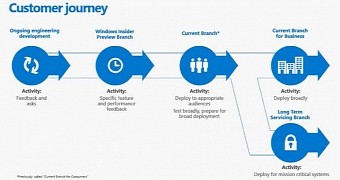Windows 10 is changing Microsoft's approach to the updating process, and once the new operating system becomes available, customers will be provided with more options (or not) depending on the version they run on their devices.
We’ve already told you that Windows 10 Home users won't be allowed to defer new updates, while Windows 10 Pro users will have such options, but in a new slide presented by Microsoft and posted by Mary Jo Foley, everything becomes a little bit clearer on how exactly new features will arrive on our computers.
First and foremost, it's worth noting that Microsoft will work with three different update branches in Windows 10 that will help decide who's getting what.
Windows 10 Home
In the case of Windows 10 Home users, often referred to as consumers, things are pretty simple. They will be included in the so-called Current Branch, which means that they'll get all their updates and new features via Windows Update.
There will be no options to defer updates or thing like that, and once Microsoft pushes the button and new patches and/or features are ready for your device, they are downloaded and installed, without the need for user interaction.
In other words, consumers will always get updates when Microsoft decides, but that should be perfectly okay because most of them aren't expected to be interested in fiddling with more advanced features when it comes to updates.
Windows 10 Pro and Enterprise
For these two SKUs, but also for Windows 10 Education, Microsoft has prepared another branch called Current Branch for Business, abbreviated CBB.
This branch brings customers the features that Current Branch does not, which means that they are allowed to delay deployment of new options. Security fixes will be installed when they are released in order to keep systems updated, but settings to defer new feature installation will also be offered.
Windows 10 Enterprise customers will get a third option called Long-Term Servicing Branch (LTSB), which will make it possible to delay delivery of new features for a maximum of 10 years, but Microsoft expects only a few people to stick to this one.
All in all, Microsoft's new strategy pretty much makes sense, given the fact that Windows as a Service is coming to life with Windows 10, but only time will tell if the company is playing the winning card with this approach.

 14 DAY TRIAL //
14 DAY TRIAL //